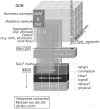Detailed clinical models: a review
- PMID: 21818440
- PMCID: PMC3092133
- DOI: 10.4258/hir.2010.16.4.201
Detailed clinical models: a review
Abstract
Objectives: Due to the increasing use of electronic patient records and other health care information technology, we see an increase in requests to utilize these data. A highly level of standardization is required during the gathering of these data in the clinical context in order to use it for analyses. Detailed Clinical Models (DCM) have been created toward this purpose and several initiatives have been implemented in various parts of the world to create standardized models. This paper presents a review of DCM.
Methods: Two types of analyses are presented; one comparing DCM against health care information architectures and a second bottom up approach from concept analysis to representation. In addition core parts of the draft ISO standard 13972 on DCM are used such as clinician involvement, data element specification, modeling, meta information, and repository and governance.
Results: SIX INITIATIVES WERE SELECTED: Intermountain Healthcare, 13606/OpenEHR Archetypes, Clinical Templates, Clinical Contents Models, Health Level 7 templates, and Dutch Detailed Clinical Models. Each model selected was reviewed for their overall development, involvement of clinicians, use of data types, code bindings, expressing semantics, modeling, meta information, use of repository and governance.
Conclusions: Using both a top down and bottom up approach to comparison reveals many commonalties and differences between initiatives. Important differences include the use of or lack of a reference model and expressiveness of models. Applying clinical data element standards facilitates the use of conceptual DCM models in different technical representations.
Keywords: Archetypes; Concept Representation; Detailed Clinical Models; Electronic Health Records; Health Level 7; Information Modeling; Templates.
Conflict of interest statement
The Windesheim'Lectorate ICT Innovations in Healthcare has no commercial interest in DCM work, but is creating evaluation methods for EHR in practice. University Medical Centre Groningen has no commercial interest in this matter, but is developing an EHR system that can be based on DCM input. Results 4 Care is developing toolsets for creation, modeling and governance of DCM. Although these tools adapt to the actual ISO 21090 standard, and ISO draft13972, some particularities in this paper might result from technical solutions created in these tools. However, we did everything in our capacity to prevent this. The work for this paper is not funded.
Figures

References
-
- Huff SM, Rocha RA, Coyle JF, Narus SP. Integrating detailed clinical models into application development tools. Stud Health Technol Inform. 2004;107:1058–1062. - PubMed
-
- Parker CG, Rocha RA, Campbell JR, Tu SW, Huff SM. Detailed clinical models for sharable, executable guidelines. Stud Health Technol Inform. 2004;107:145–148. - PubMed
-
- Goossen W. Model once, use multiple times: reusing HL7 domain models from one domain to the other. Stud Health Technol Inform. 2004;107:366–370. - PubMed
-
- Goossen WT. Using detailed clinical models to bridge the gap between clinicians and HIT. In: De Clercq, De Moor G, Bellon J, Foulon M, van der Lei J., editors. Collaborative patient centred ehealth. Amsterdam: IOS Press; 2008. pp. 3–10. - PubMed
-
- Clinical Data Interchange Standards Consortium. Round Rock (TX): Clinical Data Interchange Standards Consortium; c2010. [cited at 2010 Nov 20]. Clinical Data Interchange Standards Consortium [Internet] Available from: http://www.cdisc.org/site/index.php.
LinkOut - more resources
Full Text Sources

